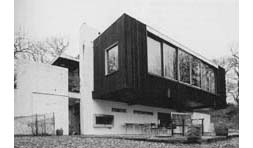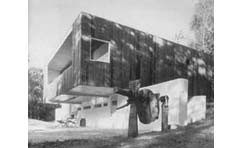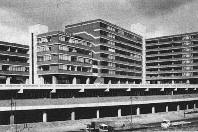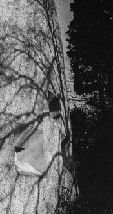Paul MacInnes writes:
Thought you might appreciate these photos.

Yes, I do. Perhaps they will remind the people who complain about Basil Spence's gorbals blocks how much more hideous life was for residents before they were built.
Paul
Sweeney writes:
In regards to your article about Sir Basil Spence's design of Glasgow International Airport and BAA's "Refurbishment" of the building by extending the terminal building to incorporate a new check-in hall and other various leisure facilities: contrary to your statement of the original cantilever structure being covered by cladding, in fact that "cladding" is actually the facade of the 1991 extension, and the cantilever facade survives intact as a gallery over the check-in hall, housing a shopping mall and International Departures as well as a viewing gallery (airside). Also at the rear of the terminal (airside) the cantilever structure still survives. For photos www.BAA.com select Quick Search Category Glasgow, then search, and then look through the subcategories on the results page, clicking search as required.
OK...so Glasgow Airport has been
covered (at the front) with an extension which is covered in disgusting
plastic cladding!
He continues:
Also please could any of your readers send me ANY material on Ruchill Fever Hospital. I saw the building today (20/5/03) and thankfully it is still standing: it has been sold to Scottish Enterprise, security has been stepped up, and only the Kitchens and Infectious Disease reasearch facilities have been demolished.
If anyone knows what Scottish
Enterprise plan to do with it, could they let the
Joy of Concrete know.
Lex
Lamb writes:
A fellow bandmember had been taking an architect relative for a visit to St Peter's Seminary over the festive season and brings reports of substantial activity: the approach road cleared and regated for heavy vehicles, amongst other signs of construction/demolition-type shenanigans in the Kilmahew estate.
Does anyone know what might be
going on there?
He continues:
Looks like your suspicions were sadly justified concerning the Anniesland art deco cinema. Dunno why they bothered; the developers might as well have slapped on a plywood facade for all that remains of the entrance barbican. Depressing (and surprising) given that it's almost opposite Kelvin Court, but there you go.
Jim Scott writes about
some Gillespie, Kidd and Coia churches. If anyone has any photos of any of them,
I’d be really grateful for a copy:
The Maryhill church dates from about 1955 (completion) and was Dutch in style
because the roof continued down to the ground in a very simple inverted V shape
with a large motif/painting of Our Lady... of Perpetual Succour(?) on the front
of the building above the lowish front doors. The design created quite a stir
amongst catholics in post war Glasgow, where I grew up. I always "understood"
it was a Coia building. I guess it was demolished 8-10 years ago. Guess! It
was on Maryhill Road, on the south side thereof, almost facing a public park.
The Drumchapel church (St Leo's) was built later and demolished earlier. It
was on a site immediately north of Drumchapel station i.e. 30 or so metres away.
It would have been built in the late 60's and demolished before 1980. I remember
hearing the then parish priest lament to his congregation that although the
"clever" architect had designed the roof in the shape of a bishop's
mitre and so had won great acclaim, he hadn't bothered to ensure that said roof
was water-tight and so the congregation would have to contribute for the repairs!
It was demolished "overnight" when Archbishop Winning was tipped off
that the building was about to be listed. ( I seem to recall that there was
an adjacent presbytery in the same design.)
"Fort Apache" was, I think, "over towards East Kilbride."
Again it wasn't much loved by the locals. ( I presume you know the story that
the designs of the Basil Spence high flats in Hutchesonstown i.e. Gorbals were
first tried out with great success in North Africa but weren't quite so functional
in Northern Europe.) [Just a story, I think. Sir Basil did dash down
to Marseille to look at Corb’s Unité as soon as he got the commission
though, so quite near North Africa!— Ed.]
Currently in Edinburgh City Museums there is a display about Scottish seminaries
on the continent, especially in Rome which is now 400 years old as an institution.
Somebody wrote an official history though my short brochure from the exhibition
doesn’t give any leads.
Samantha Hall writes:
Glasgow only seems to pride itself on drinking and distruction. oh, but they are the same thing arn't they!?
Now, Samantha doesn't say who
she is, but she neglects to mention another thing Glasgow prides itself on -
its schools, which produce people who are able to spell and punctuate.
Lex
Lamb writes:
Hello there, Mr Joy of Concrete
Just thought I'd let you know how nice it was to find some content re. St Peter’s
somewhere on the web - one of the most unforgettable buildings I have ever seen
in the most tragic but mystically inspiring condition. The Cardrossian pal who
first acquainted me with its post-nuclear charms claims to have seen a Scottish
arts documentary on the building's plight, incorporating much footage
of it as built and in use. If you haven't seen this, it might be possible to
chase it up; I could try and pin him down on a date of transmission. [Can any
other readers help on this one? - Ed.]
I'm also surprised that I'm not the only person in the world with a twinge of
regret at the passing of most of the Anderston Centre...I worked nearby for
some years, and would often enjoy a stroll through the overgrown elevated precincts
(daytime only!). The other lunch-hour option tended to be the inexplicable
and hidden amphitheatre-type seating arrangement that formed part of the Heron
House development (and sat on top of the old Habitat premises). I'm pretty sure this
quirky anomaly will have disappeared when the present works around St Vincent
St Church are complete (which looks like being another example of the conversion
of public - if underused - space to private control). [Does anyone have photos
of this they can email me - Ed.]
On a slightly different note, how about doing more on West of Scotland Art Deco?
There's a hell of a lot of fine, historically important (and quirky) Art Deco
features being lost to the city simply through a lack of recognition. Flicking
through my copy of McKean's 'Scottish Thirties: an Architectural Introduction'
the other night, I was struck by the polarised way in which (since publication)
some buildings illustrated there have vanished, others become lavishly celebrated.
I suppose this means that the case for better recognition and protection can
be more effectively made with positive examples - for example the enormous fuss
made over developments at the recently derelict Luma Light Factory or India
of Inchinnan. [I’ve got something on the cinema on Great Western Road on
the news page - if readers would like to contribute
more on threatened Art Deco, I’d be very happy to publish stories and photos
- Ed.]
Anyway - thanks again - some sound observations in your site that have cheered
me up no end!
Tom Worthington of the Ruchill Harriers writes (again - see below):
Guess where the Harriers got to yesterday? Yes we did, we found the Corbusian dreamboat of St Peters hunkered up against the years in the verdant woods of Cardross. What a fantastic place, thank you so much for turning us on to it. It's really a very profound place. What optimism and naivety produced such a behemoth? Quite how weird were the 60's architects? There is some great graffiti around the complex. A nice 'The Cramps' stencil on the ramp and unfinished tagging in the cloisters. What to do with such a place? If we ever start a cult... Yours Aye, Tom Worthington
When I win the lottery, I'm going to turn it into a free school - a Scottish version of Summerhill. Here's a link to Summerhill if you've no idea what I'm talking about.
Tom Worthington of the Ruchill Harriers writes:
Today was spent cycling up and down Cardross braes getting wonky contradictory advice off 'locals' on the whereabouts of St Peters. We never found it but we did have a very funny time looking. Can you help prevent me loosing my reputation as club secretary by telling me how the Hell to get there. Thanks.
I had exactly the same problem
the first time I tried to find it. It's at Kilmahew Ho on this map
(which is rather out of date - Kilmahew House, which St Peter's was built around,
was burnt down by vandals in 1995. Unless the map is referring to the girlfriend
of some local rap artist).
Dougie Ferguson writes:
Hi. Just wanted to tell you I love your site. I am actually looking for information on the Anderston Centre (before the bus station was taken away) and wondered if you or any of your website subscribers could help? I'm looking for this info as part of a project I am working on as I have a great fascination with 60s/70s concrete buildings. Cheers.
Dougie has had a lot of helpful replies to this and says thanks.
Robert Kelly writes
(cryptically):
Hello there, Controversial Glasgow Website: www.rkelly.greatxscape.net/glasgow [Unfortunately, Robert's site has changed significantly since I wrote the reply below, and now just seems to be advertising. If you're there, Robert, let me know where you've moved to]
What you get is completely mental (but in a good way!). Oh, except it perpetrates that old myth that Modernist architects live in Tudor mansions. As many fans know, Sir Basil Spence actually lived in a concrete and wood box that he designed himself in Beaulieu, Hampshire. Here's a couple of nice photos of it. (Apparently, he was given planning permission on the basis that the house would be half timbered. The authorities complained that he hadn't built the Tudor house they meant. He of course replied that it was half timbered -- the top half!)


Christopher Greene writes:
Is St Peter's not an example of a building neglected by Dumbartonshire?
It's actually being neglected by the Diocese of Glasgow, as far as I know. As in all things (or at least in relation to boundaries on a map), the spiritual goes way beyond the political.
Jamie Wallace writes:
I was browsing on scotland.org and came across your McPeople page. I really liked your page dedicated to other buildings which could be made up Glasgow style...LOL It made me laugh anyway!
Alan McLean
writes:
Your memories of the city must be fading. Glasgow 'wit' usually amounts to "what you gaun oan about, ya fuckin' prick?". The heavy drinking leads to broken homes, poverty and 9 year old car thiefs. Not such easy things to love when you are in the heart of it. Maybe a bit of culture might not be such a bad thing.
Name and email address supplied writes [please note that this text has been
edited at the correspondent's request]:
The world's first attempt to use design to alleviate the problems faced by people with dementia has been running as part of the [Glasgow 1999] programme [despite the fact that] the Director of 1999 said it wasn't possible because dementia is a mental illness and you can't design for it. He also wouldn't put the work on any of the official publicity, but we made him fork out some money for it anyway. We have now proved that a lot of confusion and memory problems can be designed away. Nobody got to hear about it because it wasn't sexy in marketing terms, but it has resulted in a redesign of Glasgow council housing for dementia sufferers, a new ward in Leverndale Hospital and a council old people's home completely redesigned. Work is ongoing...This project brought people from all over the world to see what we were doing, pity our own folk rubbished it!
When 1999 started, we had a promise of half the money from the Education/Community Programme. Unfortunately, the community part of the programme was given to an Education Department employee (on a secondment) and he spent most of the money on schools work, leaving nothing for Social Work.[An angry memo from] the Chief Executive's Department got Mr Sudjic moving, and he was forced to meet with us, and we outlined the project idea. His response was underwhelming, to say the least.
[Eventually we got] a grant from
the Community Programme, very grudging and only because councillors forced Mr
Sudjic. But...his excuse to keep us out of the official publicity [was that]
we weren't part of the core programme, just one of the very many grants and
they couldn't be expected to advertise everything that ran in the year. Yet
one Councillor did remark that there were endless and boring articles about
Homes for the Future, and precious little about other good things. Mr Sudjic
himself gave a presentation to councillors and made no mention of us. Boy was
I chortling when the Chair of Arts and Culture said in her thank you remarks
that she was surprised he hadn't mentioned the wonderful project on dementia,
because as she had been a carer of someone with dementia she had a strong interest
and thought the project was groundbreaking and important. Result, red faces
all round and my invitation to the official 1999 launch bash was "lost" (probably
at Mr S's request).
Sandy Forbes of Lexham Light & Sound
Ltd in Glasgow writes:
I can't agree with Stuart Graham's remarks [item below] about the Clydeway Centre. The original brickwork - engineering brick - never looked finished and simply cried out for some sort of cladding which has now improved it beyond all recognition.
I agree with his remarks about Anderston, although when we built it in the 60's it was considered the last word in housing development. The present works have improved the site enormously and have reduced the density of the building - consider the old Phase 5 area along Douglas Street, originally intended as a supermarket (was it ever used as such?), and notice how much better it is for being demolished. The old Hexagonal restaurant was another area that was not to my knowledge ever used, and the area is much better following its demolition.
Obviously the removal of traffic from the old bus station area is an improvement.
Whatever happened to the Travolator?
No, the most obvious testament to urban vandalism lies to the east along London Road where the wholesale demolition of sandstone tenements and the replacement by "modern" housing - in the days before the enlightened Frank Lafferty decided that renovation was the answer - took place.
Can anyone REALLY believe that the modern Gorbals of low rise housing in pleasing brick is no improvement on the dreadful Spence blocks, renowned for their inability to keep even the slightest shower out?
There are still though some glaring examples of buildings in need of restoration. I agree the Greek Thomson warehouse is one, but what about the southern rotunda, the Co-op building in Morrison Street, and many others? Fortunately, one of the best examples of art deco, the old Union Carbide factory, has now been preserved.
Maybe we could compile a suitable
register of those buildings which the more enlightened amongst us consider worthy
of restoration, in the forlorn hope that ONE DAY the City Fathers may sit up
and take notice.
Stuart Graham writes:
You asked in your site for examples of how Glasgow treats its architecture. You may not be aware but recently a 'Greek' Thomson warehouse building near Glasgow Cross was demolished due to it becoming unsafe as a result of years of neglect. Also, over the last few months, Jack Holmes' Clydeway centre has been re-clad in mirror glass. From a "robust, vulgar and peculiarly Glaswegian" industrial style, if the guide book was to be believed (and it was), to cheap and tacky '80s commercial dross in one easy move! (A 'before' photo is shown below left.) Sadly I think this is an even worse example of vandalism than the extension to the airport.
Large chunks of the Anderston Centre have also been knocked down. It was never the greatest building of the era but still, it is (was) of more architectural merit than the new shopping mall at the top of Buchanan Street.
I am glad to see that I am not the only person to see merit in concrete though I do think you are wrong about Spence. He was always too timid and conventional. A real second rater. Gillespie Kidd and Coia were much more convincing Corb copyists in my book. (St Peter's Seminary, Cardross, is shown below middle and right.)
 |
 |
 |